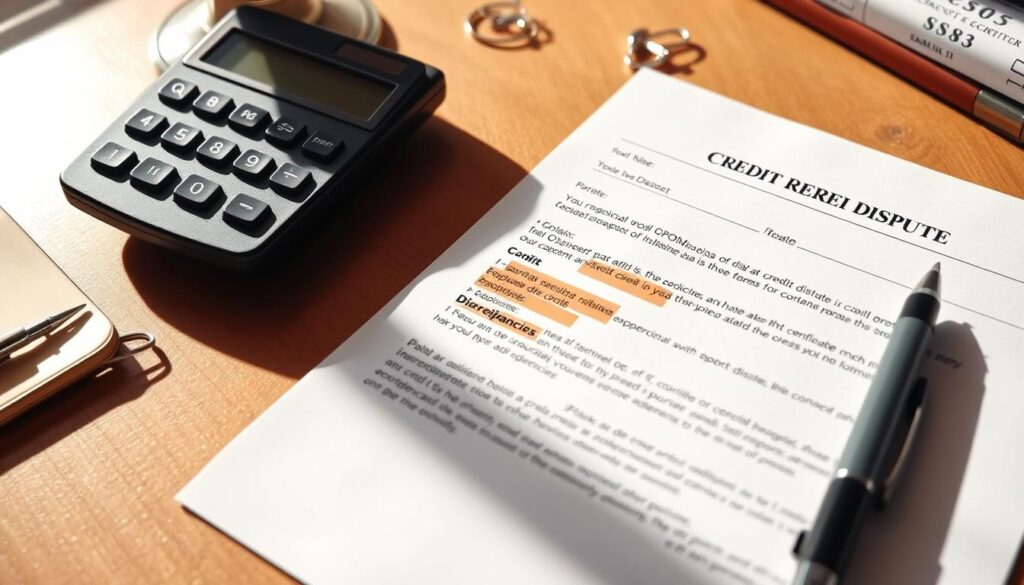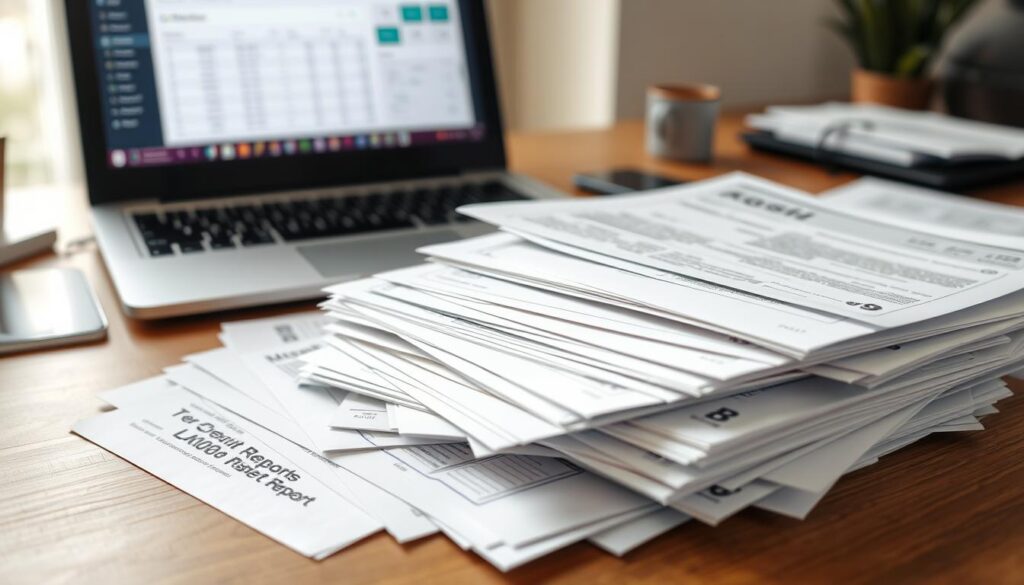Your credit report is vital for financial well-being. Errors on it can harm your credit score and financial goals. These issues can range from mistaken identity to outdated information.
Fortunately, you can address these problems effectively. With the right approach, you can restore your credit report’s accuracy. This will help you achieve your financial objectives more easily.
Key Takeaways
- Understand the importance of a clean credit report and its impact on your financial future.
- Identify common errors and inaccuracies that can appear on your credit report.
- Learn how to craft an effective sample credit report dispute letter to address these issues.
- Discover the steps to successfully submit your dispute and follow up with credit bureaus.
- Explore strategies to prevent future credit report errors and maintain a healthy credit profile.
Understanding the Importance of a Clean Credit Report
A clean credit report is vital for your financial health. Your credit score affects your ability to get loans and credit cards. It can even impact your chances of renting an apartment or landing a job.
Inaccuracies on your credit report can have serious consequences. It’s crucial to know what influences your credit score. Understanding the impact of negative credit history is equally important.
Factors Affecting Your Credit Score
Your credit score reflects your creditworthiness. It’s based on payment history, credit use, credit age, and credit types. Timely payments and low credit card balances boost your score.
A diverse credit mix can also improve your score. A higher credit score opens doors to better financial opportunities.
Consequences of Negative Credit History
A negative credit history can harm your financial future. Late payments, collections, or bankruptcy make you a high-risk borrower. This can lead to higher interest rates or denied loan applications.
You might struggle to secure housing or employment. Negative information can stay on your report for up to seven years. Regular monitoring of your credit report is essential.
“A good credit report is the key to unlocking a world of financial possibilities. Protecting your credit health should be a top priority.”
| Factor | Impact on Credit Score |
|---|---|
| Payment History | 35% of your credit score |
| Credit Utilization | 30% of your credit score |
| Length of Credit History | 15% of your credit score |
| Types of Credit Used | 10% of your credit score |
| New Credit Applications | 10% of your credit score |
Knowing what affects your credit score helps you maintain a healthy financial profile. Take steps to keep your credit report clean. This can help you avoid the problems of negative credit history.
What is a Credit Report Dispute Letter?
A credit report dispute letter helps fix errors in your credit report. You send it to credit reporting agencies like Experian, Equifax, and TransUnion. It ensures your credit bureau dispute reflects your true financial status.
This letter starts a formal investigation into disputed items. You outline issues and provide proof. The credit bureaus then check the information and make needed changes.
This process keeps your credit report accurate and protects your finances.

Fixing errors on your credit report can boost your financial health. It can improve your credit score and help you get better loan rates. It may also help with housing and job opportunities.
“Taking control of your credit report through a well-crafted dispute letter is a crucial step in achieving financial stability and success.”
Next, we’ll teach you how to write an effective credit report dispute letter. You’ll learn to fix your credit profile with confidence.
Common Errors to Look for on Your Credit Report
A clean credit report is vital for many aspects of life. It helps you get better loans, rent apartments, and even land jobs. Credit report errors happen more often than you might expect.
Knowing common credit report mistakes helps you spot and fix issues. This proactive approach keeps your credit file accurate and up-to-date.
Inaccurate Personal Information
One frequent error is wrong personal information. This includes misspelled names, old addresses, or mixed-up details with someone else. These mistakes can seriously affect your credit score and financial health.
Duplicated or Outdated Accounts
Another common problem is duplicate or outdated accounts. Creditors might report the same account multiple times. They may also fail to update closed or paid-off accounts.
These errors can inflate your credit utilization ratio. As a result, your credit score may be lower than it should be.
| Error Type | Potential Impact | How to Identify |
|---|---|---|
| Inaccurate personal information | Negatively affects your credit score and financial standing | Carefully review all personal details on your credit report |
| Duplicated or outdated accounts | Artificially inflates your credit utilization ratio, leading to a lower credit score | Thoroughly examine your account history and balance information |
Regularly check your credit report for these common errors. If you find any mistakes, dispute them right away. This ensures your credit report accurately shows your financial status.
How to Write an Effective Sample Credit Report Dispute Letter
Disputing credit report errors is vital for a healthy credit profile. A structured approach boosts your chances of success. Let’s explore key steps for writing an effective dispute letter.
Gathering Necessary Documentation
Collect all documents to support your dispute before drafting. This includes your credit report with highlighted errors. Gather evidence proving inaccuracies and copies of previous communications.
These documents strengthen your case. They provide credit bureaus with information needed for investigation and resolution.
Crafting a Clear and Concise Letter
Keep your sample credit report dispute letter clear and to the point. Identify disputed items clearly. Explain why the information is inaccurate or incomplete.
Provide details about your supporting documentation. Ask the credit bureau to investigate and correct your report information.
Following these guidelines helps craft an effective credit report dispute letter. This increases your chances of a favorable outcome.

“The key to a successful credit report dispute is to provide the credit bureaus with clear, concise, and well-documented evidence of the inaccuracies on your report.”
Sample Credit Report Dispute Letter
A well-crafted sample credit report dispute letter is vital for addressing credit report errors. It formally communicates issues to credit bureaus and requests investigation. This letter helps correct discrepancies and improve your credit profile.
Here’s a template to guide you:
“I am writing to dispute the following information on my credit report. The items I am disputing are [list the specific items] and are inaccurate. I have enclosed copies of [list the supporting documentation] to support my position. Please investigate these items and provide me with a written explanation of your findings and any actions taken to resolve the dispute.”
Include these key elements in your credit report dispute template:
- Clearly identify the specific items you are disputing on your credit report.
- Provide a concise explanation of why the information is inaccurate or incomplete.
- Attach copies of any supporting documentation, such as payment receipts or billing statements.
- Request that the credit bureau investigate the disputed items and provide you with a written response detailing their findings and any actions taken.
A well-structured sample credit report dispute letter effectively conveys your concerns to credit bureaus. It boosts your chances of correcting errors and enhancing your credit profile.
Submitting Your Dispute to Credit Bureaus
You’ve written your credit report dispute letter. Now it’s time to send it to the credit bureaus. This process might seem scary, but you can handle it with ease.
Understanding the Dispute Process
The credit bureau dispute process has several steps:
- Find which credit bureau(s) have wrong info on your credit report.
- Gather proof to back up your claim, including your dispute letter and other evidence.
- Submit your credit report dispute by mail, online, or phone to the right credit bureau(s).
- Wait for the credit bureau(s) to look into your dispute. They must respond in 30-45 days.
- Check their findings. If needed, take further action or escalate your dispute.

Knowing these steps helps you submit your credit report dispute with confidence. You can take charge of your financial future.
Following Up on Your Credit Report Dispute
Filing a credit report dispute is just the start. You must track its progress to ensure success. Staying on top of your dispute is key for accurate financial records.
Tracking Your Dispute Progress
After submitting your dispute, it’s crucial to monitor its status. Credit report dispute follow-up helps ensure timely responses from credit bureaus.
Here are tips to effectively track your credit report dispute:
- Note the submission date and set reminders for 30, 60, and 90 days.
- Contact credit bureaus directly about your dispute status. Keep detailed records of all conversations.
- Check your credit report often for updates on disputed items. This helps confirm successful credit report dispute resolution.
Stay diligent and persistent in your follow-ups. This approach ensures credit bureaus address your concerns efficiently.
Regular monitoring helps maintain an accurate credit report. Your efforts can lead to a cleaner financial record.
| Action | Timeline |
|---|---|
| Submit credit report dispute | Day 1 |
| Follow up with credit bureaus | Day 30, 60, 90 |
| Review updated credit report | Ongoing |
“Persistence and diligence are the keys to resolving credit report disputes successfully.”
Preventing Future Credit Report Errors
Keeping your credit report accurate is vital for your financial health. After fixing errors, take steps to protect your financial future. Here are some strategies to prevent future credit report errors:
- Regularly Monitor Your Credit Report: Sign up for a credit monitoring service or check your reports yearly. Review reports from Experian, Equifax, and TransUnion to spot and fix any prevent credit report errors quickly.
- Keep Track of Your Credit Report Maintenance: Make credit report maintenance a habit by reviewing it often. Check that all info, including personal details and account history, is correct and current.
- Dispute Errors Promptly: Notice any credit report errors? Act fast and dispute them with credit bureaus. Quick action can protect your credit monitoring and overall financial standing.
Being proactive about your credit report can lower the risk of future errors. It helps safeguard your financial well-being.
A clean credit report builds a strong foundation for your financial future. Stay vigilant to maintain a healthy financial profile.
“Keeping a close eye on your credit report is the best way to prevent future errors and maintain a healthy financial profile.”
Conclusion
Crafting an effective sample credit report dispute letter is crucial for accurate credit records. It’s a key step in improving your credit score. This guide equips you with the tools to confidently navigate the dispute process.
Addressing credit report inaccuracies is your right and a powerful credit repair tool. A well-written credit report dispute letter can effectively challenge errors. This paves the way for a more accurate credit report.
You now have the knowledge to safeguard your financial well-being. Take proactive measures to improve your credit score. Your financial future is in your hands.
With the right approach, you can successfully navigate credit report disputes. Use these strategies to secure the credit you deserve. Your journey to better credit starts now.

